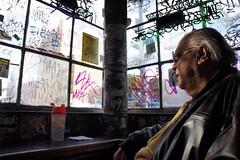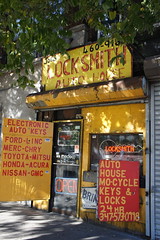 Stephanie Butnick The buildings at 9, and 11-17 Second Avenue, which will be renovated as part a new development featuring low-income apartments that would be available for as little as $1.
Stephanie Butnick The buildings at 9, and 11-17 Second Avenue, which will be renovated as part a new development featuring low-income apartments that would be available for as little as $1.Developers are expected to seek Community Board approval Wednesday for a plan to renovate a row of properties along Second Avenue, and sell some of the apartments to low-income families for as little as $1.
The mostly low-income families who currently live in the two buildings at 9 and 11-17 Second Avenue are guaranteed units in the proposed development, which would combine the two structures into one larger building.
The project, run by development firm BFC Partners, is operating under the Department of City Planning’s 2009 amendment to the inclusionary housing program, which creates permanently affordable housing, now with the option to buy. According to Juan Barahona of the development firm, tenants will be able to buy the new apartments for between $1 and $10.
The project will also take advantage of new zoning laws that allow developers to build more square footage on a lot, provided they allocate 20 percent of the building’s total area to affordable housing.
In this case, the 12-story, 4,000 sq. ft. building will house approximately 12 low-income units (available to those making 80 percent or less of the area’s median income ̶ approximately $63,000), dispersed throughout the complex, and about 48 market rate units. The development’s market-rate units, which make up the majority of the building, will offset costs.
When the Urban Homesteading Assistance Board acquired 9 Second Avenue in 2002, one option was to reconstruct the existing units, which are in poor condition and in some cases need to be brought up to code. But with this collaboration they can provide tenants with entirely new units – and an elevator.
Sounds like a coup for low-income housing supporters, but some Community Board 3 members expressed concern about the project at an informational meeting last month, particularly about the number of low-income units that would be made available.
“I wish it could be a lot more,” Val Orselli of the Cooper Square Mutual Housing Association told The Local after the meeting. “Maybe they could sweeten it a little if they get a 421a” – essentially a tax abatement.
Mr. Barahona, who also attended the meeting, said that even an abatement would likely not affect the number of low-income units.
 Stephanie Butnick Mars Bar owner Hank Penza said he was approached by the developers about the project, which would force the temporary closure of the longtime East Village bar.
Stephanie Butnick Mars Bar owner Hank Penza said he was approached by the developers about the project, which would force the temporary closure of the longtime East Village bar.Other committee members pushed developers to consider making the apartments smaller so that the required 20 percent of the total area allotted to low-income housing could include more units.
There were also concerns about whether the low-income units would remain that way permanently. Andrew Reicher, executive director of the Urban Homesteading Assistance Board, who assured the committee that his board would oversee the resale of the affordable units, said the new regulations ensure that the resale value of the affordable units can only increase marginally, and will ultimately only be available only to those making up to a maximum of 125 percent of the area’s median income.
The significance of this new development is that the units will be permanently allocated to affordable housing. Since many rentals have contractual limits on how long they must be affordably priced – Reicher pointed out that even 50-year restrictions do come to an end at some point – rent charges will inevitably price out lower income tenants. The permanence of these restrictions, combined with the novel homeownership option, ensures that these units will remain affordable indefinitely.
The nine low-income families already living in the building will have to be relocated for the duration of the construction, or roughly two years. But Mr. Barahona told committee members at the meeting that the cost of moving and housing these tenants would be “on BFC’s dime.”
 Stephanie Butnick Local businesses, such as Joe’s Locksmith, have expressed support for the development plan.
Stephanie Butnick Local businesses, such as Joe’s Locksmith, have expressed support for the development plan.Still, most residents are in favor of the project. The tenants of 11-17 Second Avenue sent a representative to November’s meeting to express their support in a statement, saying “We need a new space that’s more livable.”
As for opposition to the development – there is a public comment session scheduled for Wednesday’s committee meeting – Mr. Reicher says he doesn’t know what to predict. Neighboring businesses, such Joe’s Locksmith and Mars Bar have already expressed their support – even though it will mean they, too, will have to move for the duration of the project.
“They won’t choke me,” Hank Penza, the longtime owner of Mars Bar, said of the developers, adding, “I didn’t get off the boat yesterday with a pound of spaghetti in my hand.”
Mr. Penza said that he wasn’t too concerned about the lost revenue, noting that he’ll ultimately get a space that’s three to four times the size. The developers, he said, “are good people” – and that seemed enough for him.
Of course, not everyone is so optimistic. One tenant, asking to remain anonymous, told The Local of the project, “I’m very anxious. It’s uncertain.”
If the board approves the application, it will go next to the borough president for approval and then to the City Council for a vote. The whole process usually takes about seven and a half months.
Mr. Barahona said if the plan is approved, construction, which is projected to last around 18 months, could begin as early as this summer.



